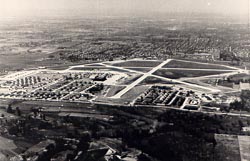
The Bowman Field Historic District in Louisville, Kentucky, includes three adjacent buildings related by history, function and physical proximity. They are the airport Administration Building, the Curtiss Flying Service Hangar and the Army Air Corps Hangar. Although these buildings, along with their surrounding greenspace and service areas, comprise only a small portion of the present total acreage of Bowman Field, they constitute the airfield's historic core. These buildings were designed in the Art Deco/Art Moderne style and were constructed of brick, stone and concrete. They possess a high degree of integrity. The dominant landmark of Bowman Field is its terminal, more commonly known as the Administration Building, appropriately styled in aerodynamic Moderne. As constructed in 1929, it was a fairly modest two-story building with one-story wings, housing administrative and communications offices, a weather station and restaurant. From 1936 to 1937 it nearly tripled in size, and the east wing was demolished to make way for a larger building attached to two-story central section and west wing. The Administration Building is now a symmetrical five-part composition, with a three-story central block flanked by slightly recessed two-and one-story wings, resulting in a stepped-ziggurat-like design. The interior of the Administrative Building retains much of its original 1930s flavor.

Both of the airplane hangars included in the Bowman Field Historic District are typical of aviation-related structures of the 1920s and 1930s in their use of metal construction, masonry veneer, and restrained Moderne-inspired detailing. The earlier of the two, the Curtiss Flying Service Hangar, was built concurrently with the Administrative Building in 1929. The hangar is constructed of steel faced with light-yellow smooth-surface brick in common bond and features pilasters that culminate in concrete capitals featuring stylized geometric designs. The Army Air Corps hangar, built from 1931 to 1932, is located opposite the Curtiss Flying Service Hangar on the west side of the airfield. It is a massive double-gabled structure divided by a partition wall and adjoined on the north and south by lower one-story wings. Like the Curtiss Flying Service Hangar, it is built of steel and faced with yellow brick, which has since been painted ivory.
The land on which Bowman Field was built was previously owned by a German national, Baron Klaus von Zedtwitz, and seized during World War I by the U.S. government under the Alien Property Act. Once peace returned, part of the land was leased from the government by aviation enthusiast Abram H. Bowman, who hoped to establish an airport on the property. Bowman, proprietor of a local trucking company, became interested in aviation after World War I. Although he never learned to fly, he purchased a Canadian JN-4 airplane formally owned by pilot Robert Gast. After securing the Von Zedwitz property, he offered the public rides in the JN-4, which was piloted by a colleague. Local tradition has established 1919 as the year the first airplane landed at what would eventually become Bowman Field. During its early years, Bowman Field appears to have been a rather modest operation. A chronology of Louisville included in the popular Louisville Panoramalists 1921 as the year "the airport opened at Bowman Field." During that year, the airport's first substantial structure, a wooden hangar, was constructed with salvage lumber. When the wooden hangar was destroyed in a windstorm, a discouraged Bowman talked of abandoning a private airport scheme all together, but friends persuaded him to revive it in a new form, as the home of a military air unit. During the early 1920s, the Army was attempting to stimulate national interest in aviation by establishing "Army Airways." In 1922 a Louisville delegation including Mayor Huston Quinn, Abram Bowman and others approached the Army about establishing a base at Bowman Field. Their efforts were successful, and later in the year Bowman's lease on the property was taken over by the Army. The airfield then became the home of the 465th Army Pursuit Squadron, and its new identity as a combination military/civilian facility was established. Bowman Field was officially dedicated on August 25, 1923, and the Squadron remained the airfield's principal tenant for the next five years.

During the 1920s benches were installed at Bowman Field to accommodate crowds of tourists who flocked there to watch the airplanes. One of the high points in the airport's history took place in 1927 when 10,000 spectators flocked to see famed aviator Charles Lindbergh and his Spirit of St. Louis. By 1928, the city of Louisville had acquired clear title to the von Zedtwitz property with the intention of developing it as an airport, since the city's only other aviation facility had long since closed. During the late 1920s the Air Board initiated an ambitious improvement program in conjunction with the Army, which saw the construction of the Administrative Building and the hangars. By 1940 the government increased the size of Bowman Field, and during World War II the training of air evacuation flight nurses and combat glider pilots occurred here. During the postwar era, Bowman Field shared in the unprecedented growth of commercial aviation. In 1957 Bowman Field was recognized by the Federal Aviation Administration as the nation's busiest general aviation airport.
Visit the National Park Service Travel American Aviation to learn more about Aviation related Historic Sites.
![]()
Last updated: August 29, 2017
